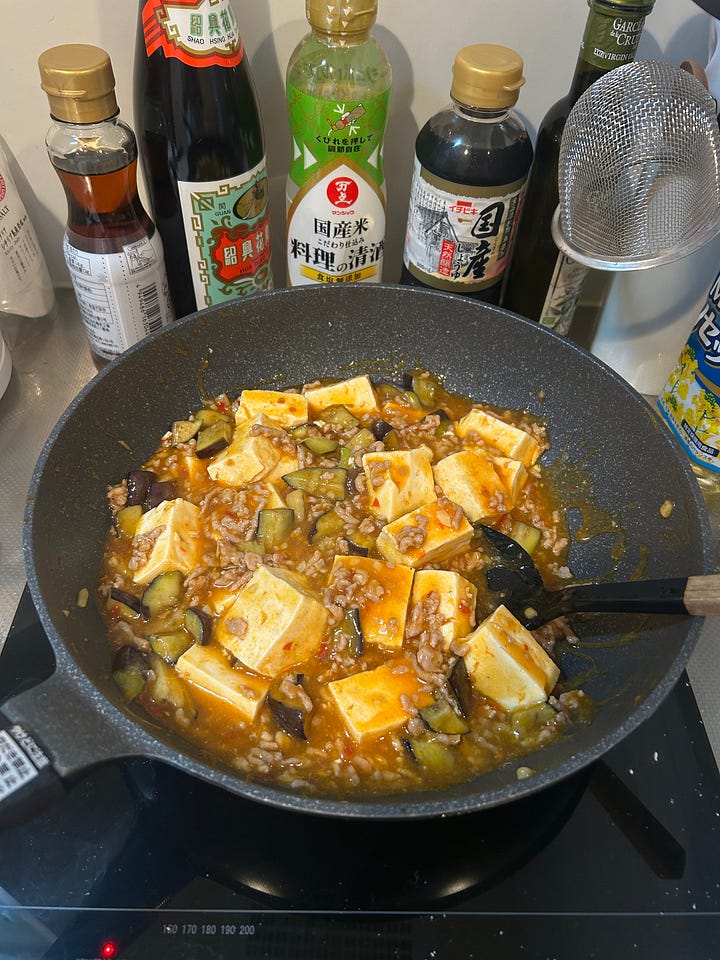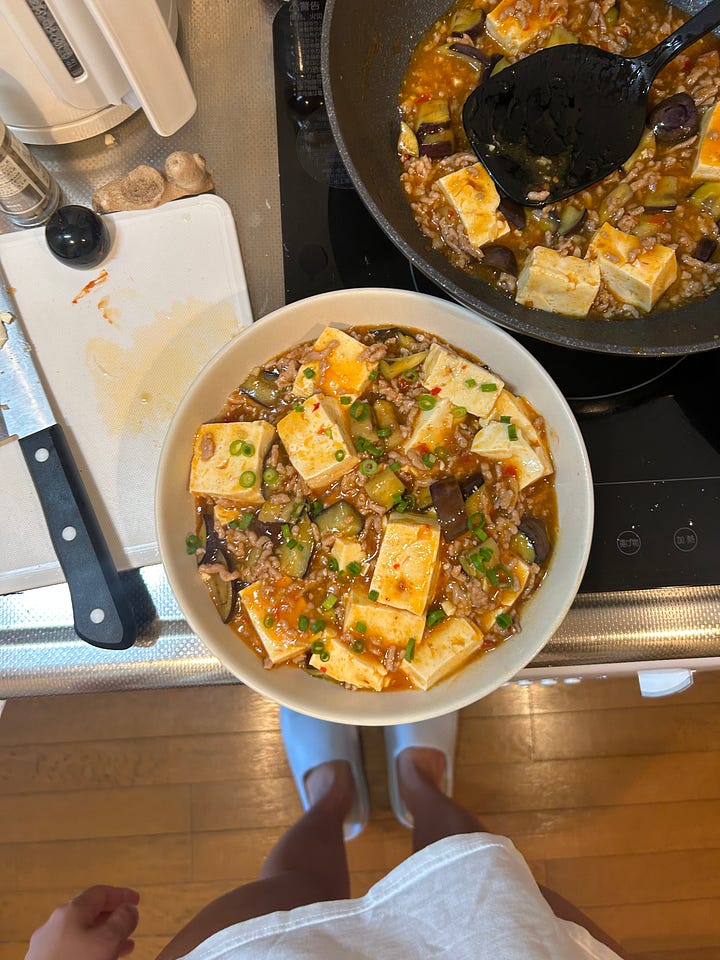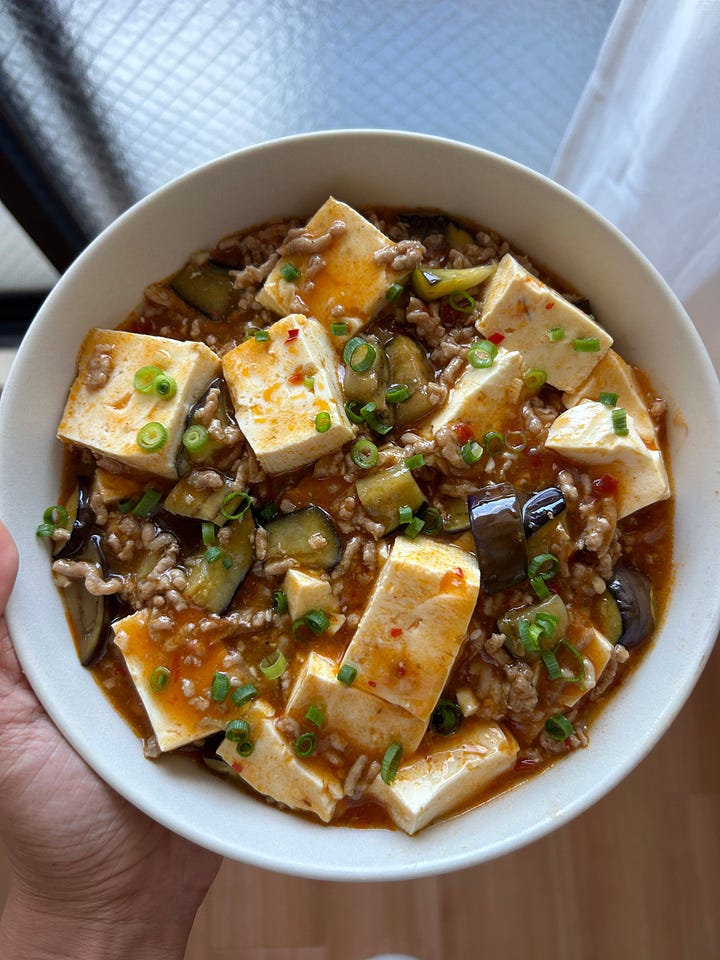Cooking in a tiny apartment with a single burner and a one-wok recipe for eggplant mapo doufu
What I've been eating, some notes on cooking in a tiny kitchen, meal planning, and a recipe to remind me of home
I moved into my Tokyo apartment having already braced myself for a tiny kitchen, which I knew would be less of a kitchen and more of a kitchenette, made even more evident by the fact that it’s built into my hallway and directly across from my even smaller bathroom. Still, a home is a home. As you walk into my apartment, the kitchen’s about a metre long and equipped with a reasonably-sized sink (enough to stack my pots and dirty dishes), a miniature washing machine, a single induction burner entirely in kanji, a built-in drying rack that conveniently hangs above the sink, and a small cupboard with a sliding glass door that should be a display case for my tableware, but is currently full of cornstarch, dashi, sugar, salt, pepper, Chinese chicken bouillon powder, black fungus, fensee, pasta, and other miscellaneous spices and seaweeds. Despite my counter’s limited real estate, there’s enough room for a second hot plate, which I’ve finally gotten around to buying—one burner was manageable, but it certainly interrupted the flow of cooking. With a small step down from my kitchen and into my bedroom, you’ll find my fridge in the right-hand corner crowned with my microwave oven, as well as my shelf that stores my tiger rice cooker, muji kettle, wok, steamer pot, bowls, and plates.
This was all discouraging at first. The question of how I could cook in this tiny kitchen, let alone do without an oven kept recurring. But, once I started familiarizing myself with my kitchen—the pivot to the fridge and the stretch around the wall to my shoe closet’s makeshift counter—I began to find rhythm in the slightly disjointed charm of cooking in a small space. It forced me to be intentional with each step, efficient with my timing, resourceful with my space and organized with my food prep. The dish rack above my sink has became the station for all my prepped ingredients. Below it, between my hot plate and sink, I chop at my cutting board with one hand and with the other, migrate the ingredients into bowls then onto the drying rack while watching as the translucent edges of my onions deepen in colour as they sizzle in the wok’s hot oil. These are the routines and rotations I’ve gotten used to.
Some main takeaways from working with a tiny home kitchen:
Accept the difference - I’ve always been a perfectionist with very particular ideals that I find hard to let go of. I miss having a kitchen nearly the size of my current apartment and I miss having cupboards, but missing these things doesn't negate the fact that cooking a good meal at home is still entirely possible. Any flat surface can act as a counter top, and while above the shoe closet feels like a strange place to set aside a pot of miso soup, and laying out your ingredients on the drying rack may be a bit of a balancing act sometimes, your space will work for you in the ways that it can.
Make use of the ingredients you have on hand - prior to living a small space, when I had enough storage space to organize cupboards by cuisine—aka my “white people food cupboard” and “Asian food cupboard”—I was a bit of a hoarder when it came to dry goods and ingredients. Having 8 different pasta shapes is fun, but also excessive. Work with what you have on hand and try to be minimal when it comes to grocery shops by really focusing on cooking with staples.
Meal plan - having a general meal plan for the week is a lifesaver when it comes saving fridge space (and money!). I’ll typically do two grocery shops a week—once on the weekend and one mid-week to stock up on any ingredients I missed or ran out of. For me, a typical meal plan/grocery shop list consists of choosing something I’m craving that week and building two other meals off of their shared ingredients. Last week looked something like this:
Basics:
Yogurt
Fruit
Eggs
Nattō
Backup veggies if I ever need a quick salad for lunch (shredded cabbage, cucumbers, tomatoes, etc.)
Craving: Japanofied bolognese.
Udon
Ground beef + pork
Eggplant
Can of chopped tomatoes
What can I do with the extra eggplant because they’re usually in packs of three? Chicken stir fry in sweet and sour sauce with veggies
Boneless chicken thighs
Broccoli
Lotus root
OR mapo doufu (which I’ll be sharing the recipe for below)
What can I make with the extra lotus root? Lotus root stuffed with pork with okra
Okra
Stir-fried udon with ground beef, eggplant, tomato sauce
Sweet and sour chicken with eggplant, broccoli, lotus root
Chicken stuffed lotus root with okra
Mapo doufu with eggplant




Since being in Japan, I’ve come to realize that the mapo doufu I’ve grown up eating (my mom’s Cantonese style) is actually much more similar to the Japanese mabo tofu than the authentic Chinese dish itself. In this recipe I’ve added eggplant because I had it sitting in my fridge and omits the numbing spice (since there are no peppercorns), instead focusing on more of the fermented, savoury flavours, and getting a little kick from the doubanjiang (fermented chilli bean paste.)
Recipe below ↓
Keep reading with a 7-day free trial
Subscribe to alexacooksme to keep reading this post and get 7 days of free access to the full post archives.






